Makiwara — tire type.
by Ryan Gregory, April 14th, 2012I discussed the purpose and construction of a makiwara in a previous post. The platform type that I built last time is good if you want to have a self-contained version of the traditional style that you can move from one room to another or take outside, rather than having it buried in the ground or attached to the floor of the dojo. However, it’s heavy and is at best only semi-portable.
So, I decided that I would also make a smaller type of makiwara that can be mounted on the wall. Of course, you can buy small, wall-mounted makiwara that consist of a leather pad on a piece of wood, which in turn sits on top of a foam cushion inside a metal bracket. We have one of these in the dojo, and it seems to work well. It would be easily portable based on its size, but I am not sure how simple it is to mount/unmount it.
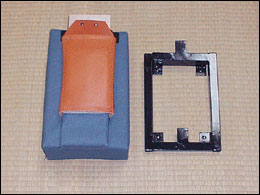
As you may have guessed, the fun part for me is to make my own equipment using materials that are readily available. So, with that in mind, here is the second type of makiwara that I have built. This one makes use of an old car tire and is truly portable.
The first step is to get an old tire. Tire shops and auto mechanics are good places to try, especially because you will probably be able to select the size that you want. In all likelihood, they will let you have a tire or two for free since they will just be recycled anyway. In my case, I had access to a large pile of tires that some jerk had dumped next to a walking trail near where I live. I spent a Sunday morning hauling them all out of the brush and am planning to dispose of them properly. In the meantime, I have lots of tires to choose from for this sort of project.
Anyway, once you have the tire, it is a good idea to wrap it in tape because, well, tires are dirty. I chose to use hockey tape but duct tape would work fine as well.

Just to make it interesting, I made a little pattern with black and white tape. I actually decided to make two of these at the same time, using two different tire sizes. One was a standard car tire and the other looked like a trailer tire.

Once the tire is wrapped in tape, cut it down the middle all around the inside, and then stick it to the inside walls of the tire. Basically, the flexing of the rubber is what will provide the cushioning for the strikes, so it’s better to have the two walls of the tire free to give and rebound properly.

The next part that you need is a piece of hardwood and some material for making the striking target. It so happened that we have a box of hardwood flooring planks left over from some renovations that we did several years ago, so I just used small pieces of this wood.
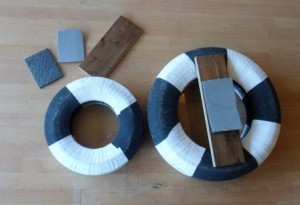
For the striking target, I used two types of foam: the black foam flooring that I used when making the breaking board holder, and the grey camping foam that I used in the heavy bag arm project. I simply taped these to the board and wrapped them with hockey tape. This made for a nice pad for striking.

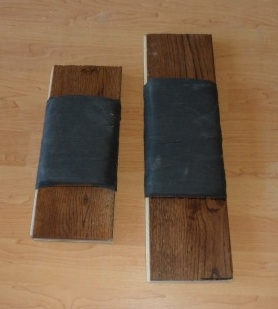
Then it was time to add the leather. I picked up a well used leather jacket from Value Village for about $10, which provided enough leather for lots of these covers. Just to make it seem more authentic, I attached the leather by tying it on the back. You could just as easily tape it on.

Once completed, I drilled four holes into the wood and through the tire, and bolted the boards on to the tires. I used lock nuts and included a washer on top of the wood and another one underneath between the nut and the rubber. I also drilled a hole in the top of the tire and attached an eye bolt (again, with two washers). I mounted the makiwara on the wall by hanging it from an eye bolt and ring that was screwed into a piece of wood attached to the wall and was aligned with a stud. Note that the walls in my garage are wood, not drywall, so you will need to take this into account if you want to mount one of these somewhere in your house. I assume no responsibility for any damage that you do to yourself or your walls!
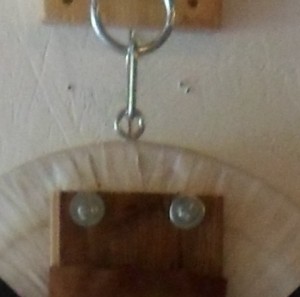
I also added an eye bolt to the bottom of the smaller tire and attached the larger one to it. Here is the finished product:

This is very cool because it provides two different targets, one at about head height and one around stomach height. It’s fun to throw combinations at the two targets, like you might do on a heavy bag — but with the benefit of the progressive resistance that you get with a makiwara. The makiwara generally doesn’t swing from side to side unless you give it a push (which can be interesting as well).
The double makiwara is part of the home dojo I am building in my garage, and is conveniently located near my heavy bag. This allows me to practice combinations on multiple opponents. Because they are attached by clips, the makiwara can be used together or one at a time, and the height can be adjusted easily by using a chain. They can also be removed easily and replaced with other pieces of equipment that can hang from the eye bolt. For example, I have since attached a chain to my breaking board holder so that it can now be hung in place of the makiwara if I want a different sort of target to hit. It’s a quick-change system for punching targets!
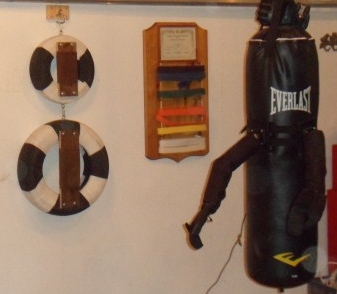
Overall, I am very happy with this makiwara. It was pretty easy to make and it cost almost nothing (just some tape, foam, old leather, and bolts). I think it looks good on the wall as well. The ability to quickly change it for other pieces of equipment or to adjust the height is excellent. And it provides a great use for an old tire.
The idea for making this type of makiwara came from a couple of sources, including the videos here and here, and The Art of Hojo Undo by Michael Clarke. This is my own take on the design (one of the others is hand-held whereas another is screwed directly to the wall — plus mine has double targets).

 Brazilian Jiu-Jitsu
Brazilian Jiu-Jitsu
 Kodokan Judo
Kodokan Judo



[…] as well as traditional implements for hojo undo like the makiwara. I mentioned that the tire-type makiwara that I made is particularly neat because it can be quickly swapped out for other striking targets […]
[…] to construct your own makiwara (FTSV Jahn Brinkum) * Makiwara — platform type (Back in the Gi) * Makiwara — tire type (Back in the Gi) * Ultimate Makiwara (plans for purchase) * Makiwara Construction Guide (plans for […]
[…] (Originally posted on Back in the Gi) […]
Thanks for the post. I made a similar makiwara on a tire and had it in the garage for a while. I found it did not give as much as my floor mounted makiwara, so I had to hold back to avoid injuring joints. But it is an elegant concept. It’s not very different from the concept of the wall mounted wing chun bag. So I bought one (a 3 section canvas wall bag) and filled it with beans and a little rice. I can always eat it if I don’t like punching it. I’ve been experimenting with it free-hanging (can fully penetrate with no fear of injury) and trying to hang it closer to the wall. I will next hang it on the wall- (cannot fully penetrate, but it stays still so you can practice rapid succession combinations). In theory, you can punch it and the beans displace as you penetrate, but I don’t expect to be able to blast through it like on my old makiwara. Still- it is really nice to use. For a really solid punching alternative to a makiwara – one that you can totally penetrate through- I tried one of those blue vinyl “shock bags” that are advertised as being mounted in a doorway with bungee– but I simply free hang it from two cords. Packed with beans and sand it offers perfect resistance for all out punching like a makiwara.